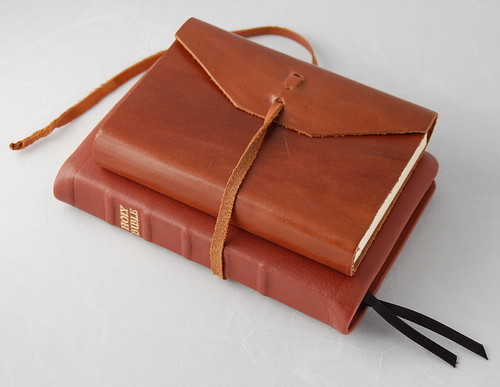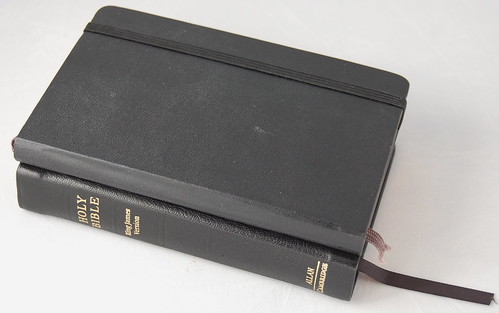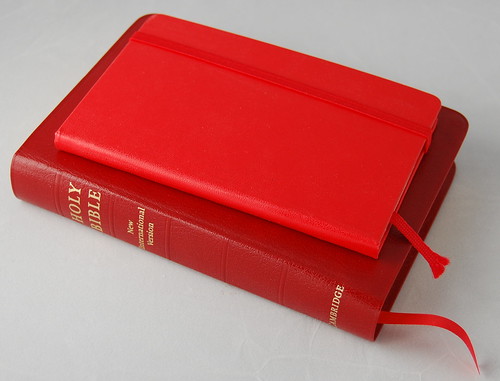Bibles and Notebooks
Wide-margin Bibles are one way to keep your notes, but there's an argument to be made for using a separate journal. A teaching outline can get pretty cramped in the confines of an inch-wide margin. Using a notebook gives you room to spread out. They're easier to write in, too, when your only solid surface is your lap, as is so often the case when you're sitting in church, taking notes on a sermon. Sometimes you don't want to carry all your notes around with you, either. A separate journal gives you the option of leaving them at home. With that in mind, let's take a look at a few combinations:
Above, you get a glimpse of the combination I took to my last Worldview Academy retreat. I had to pack light, and the Compact ESV is nothing if not small. It slides right into an inner pocket in my briefcase. My matchy-matchy nature dictated the rest. The brown leather journal had been sitting idle for a couple of years -- I bought it on a whim but, thanks to Moleskines, never used it. In practice, I found the flap a little awkward to wield, so I ended up not using it as much as I otherwise might have. Lesson learned.
Above, a typical combination for church. Growing up, I always attended churches with traditional pews, giving me room to stack Bible, hymnal and whatever else I happened to have nearby. For the past few years, though, my churches have all been pew-free, featuring various kinds of stackable chairs. Since I have nowhere to put things but the floor, I tend to gravitate toward Bibles I can slip in a pocket when I need a free hand. The Crystal KJV from R. L. Allan with its beautiful goatskin cover and clear text is perfect for the job -- and it happens to coincide pretty closely with the measurements of a black Moleskine notebook.
Above, a due that doesn't work, as much as I'd like it to. I love red. I have a red Cambridge NIV and a red Moleksine, so it's a match made in heaven, right? Not so much. The reds actually clash, as you can see, and the difference in sizes makes it harder to keep a grip -- the notebook likes to slide right out of my hand. In fact, if there's any "lesson" in my own experience, it's been that the closer the match between the Bible and the notebook, the handier the combination. If it's a close match, the two become one in your hand. Otherwise things can get a little awkward. (Then again, maybe it's the clash of reds throwing off my motor skills.)
Finally, the tag-team I took with me for Worldview Academy 2007. Spending two months on the road is always a challenge, partly because I have to decide which Bible to take. It has to stand up to abuse and be convenient for teaching. It also has to be replaceable, just in case I misplace it. The Journaling Bible did sterling duty across the board -- and yes, in spite of the extra space in the margins for notes, I still kept an extra notebook handy, this time a full-size Moleskine. At the beginning of the summer, it was pristine, but eight weeks later it looked like an old-fashioned steamer trunk.
How about you? Do you have a favorite companion notebook? I've corresponded with some people who are pretty fanatical about the subject. The last thing I want to do, as you know, is introduce more fanaticism into anyone else's life. But I'm interested in other people's note-taking habits, including the journals they choose. Does everyone try to match journals to Bibles, or am I in the minority on that one? More on that one another time ....
J. Mark Bertrand is a novelist and pastor whose writing on Bible design has helped spark a publishing revolution. Mark is the author of Rethinking Worldview: Learning to Think, Live, and Speak in This World (Crossway, 2007), as well as the novels Back on Murder, Pattern of Wounds, and Nothing to Hide—described as a “series worth getting attached to” (Christianity Today) by “a major crime fiction talent” (Weekly Standard) in the vein of Michael Connelly, Ian Rankin, and Henning Mankell.
Mark has a BA in English Literature from Union University, an MFA in Creative Writing from the University of Houston, and an M.Div. from Heidelberg Theological Seminary. Through his influential Bible Design Blog, Mark has championed a new generation of readable Bibles. He is a founding member of the steering committee of the Society of Bible Craftsmanship, and chairs the Society’s Award Committee. His work was featured in the November 2021 issue of FaithLife’s Bible Study Magazine.
Mark also serves on the board of Worldview Academy, where he has been a member of the faculty of theology since 2003. Since 2017, he has been an ordained teaching elder in the Presbyterian Church in America. He and his wife Laurie life in Sioux Falls, South Dakota.




